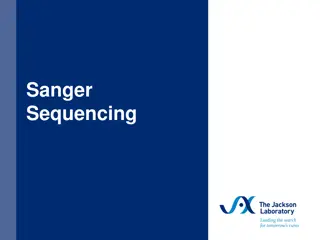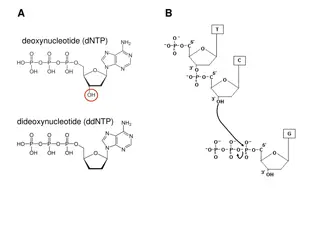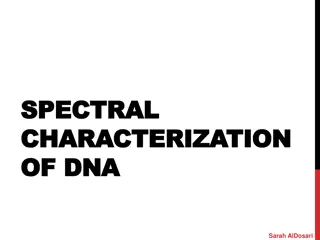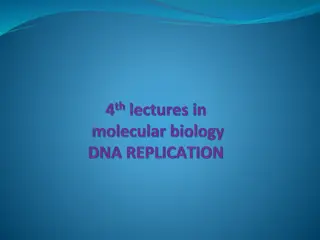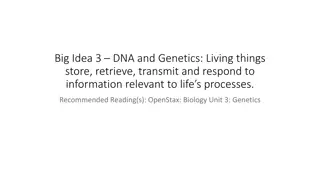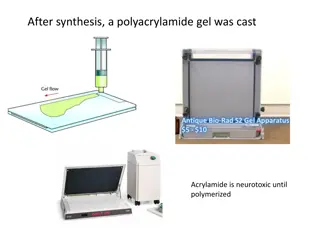Understanding DNA Sequencing: Principles, Applications, and Techniques
DNA sequencing plays a vital role in various fields such as research, diagnostics, biotechnology, forensics, and biological systematics. By determining the order of nucleotide bases in a DNA molecule, it helps in understanding genetic sequences, identifying mutations, and completing projects like the Human Genome Project. DNA sequencing is also used in forensics for individual identification through unique DNA sequences present in hair, skin, blood, and other samples. The process involves purification, labeling, gel electrophoresis, autoradiography, and PCR techniques to sequence specific genes.
Download Presentation

Please find below an Image/Link to download the presentation.
The content on the website is provided AS IS for your information and personal use only. It may not be sold, licensed, or shared on other websites without obtaining consent from the author. Download presentation by click this link. If you encounter any issues during the download, it is possible that the publisher has removed the file from their server.
E N D
Presentation Transcript
DNA sequencing and fingerprints Dr. Sudha Kumari Assistant Professor Department of Veterinary Microbiology Bihar Animal Sciences University, Patna
INTRODUCTION The term DNA sequencing refers to sequencing methods for determining the order of the nucleotide bases adenine, guanine, cytosine, and thymine - in a molecule of DNA. Knowledge of DNA sequences has become indispensable for basic biological research, other research branches utilizing DNA sequencing, and in numerous applied fields such as: Diagnostic, Biotechnology, Forensic Biology And Biological Systematics.
PRINCIPLE purification of the DNA fragment that to be sequenced and labeled with radioactive material. Chemical treatment generates breaks at a specific nitrogenous bases and thus a series of labelled fragments is generated. The fragments in the four reactions are arranged side by side in gel electrophoresis for size separation. The fragments visualize in X-ray for autoradiography.
To visualize the fragments,the gel is exposed to X-ray film for autoradiography,yielding a series of dark bands each corresponding to a radiolabelled DNA fragment,from which the sequence may be inferred.
APPLICATIONS: With its study we can understand the function of a specific sequence and the sequence responsible for any disease. With the help of comparative DNA sequence study we can detect any mutation. DNA fingerprinting. By knowing the whole genome sequence, Human genome project get completed.
Forensics:- DNA sequencing has been applied in forensics science to identify particular individual because every individual has unique sequence of his/her DNA. It is particularly need to identify the criminals by finding some proof from the crime scene in the form of hair, nail, skin or blood samples. Steps: 1. Denaturation 2. Primer attachment and extension of bases 3. Termination 4. Gel electrophoresis procedure
Technique Gene to be sequenced subjected to standard PCR Amplicon will have number of copies of the gene under question Now, sequencing PCR is run using this amplicon as template To run this reaction we add Buffer The template i.e. amplicon from the first PCR Primer Big Dye Polymerase + mixture of ddNTPs and dNTPs Double distilled water
ADVANTAGES One major application of DNA testing is in forensic identification; DNA test results are much clearer than fingerprints and it is with these results and proof that it is possible to find criminals; DNA evidence from blood, skin or hair can be matched to the DNA of a suspect to determine information about where an individual was and who they may have come in contact with; DNA analysis is especially important in cases of rape, where doctors can often examine a victim and find traces of the rapist's DNA.
DISADVANTAGES One key disadvantage of DNA analysis is the potential for invasion of individual privacy; Because a person's DNA reveals so much information about their physical state, it is sensitive information that must be carefully guarded; Information about an individual's ethnic background and parentage could become cause for discrimination; Disadvantages include incomplete coverage, which can lead to false normal results, and the ability to test only for unbalanced rearrangements (duplications and deletions), and not balanced translocations or inversions
What is DNA Fingerprinting? The chemical structure of everyone's DNA is the same. The only difference between people (or any animal) is the order of the base pairs. The information contained in DNA is determined primarily by the sequence of letters along the zipper. DNA fingerprinting, also called DNA typing, DNA profiling, genetic fingerprinting, genotyping, or identity testing, in genetics, method of isolating and identifying variable elements within the base-pair sequence of DNA
History DNA fingerprinting was developed in 1984 by Alec. J. Jeffrey at the University of Leicester while he was studying the gene for myoglobin He found that myoglobin genes contain many segments that vary in size and composition and have no apparent functions
Steps: Collection of a biological sample- blood, saliva, buccal swab, semen, or solid tissue. DNA extraction Restriction digestion or PCR amplification Agarose gel electrophoresis, capillary electrophoresis or DNA sequencing Interpreting results
Procedure of DNA fingerprinting 1 Isolation of DNA. DNA must be recovered from the cells or tissues of the body. Only a small amount of tissue - like blood, hair, or skin - is needed. For example, the amount of DNA found at the root of one hair is usually sufficient. 2 Cutting, sizing, and sorting. Special enzymes called restriction enzymes are used to cut the DNA at specific places. For example, an enzyme called EcoR1, found in bacteria, will cut DNA only when the sequence GAATTC occurs.
The DNA pieces are sorted according to size by a sieving technique called electrophoresis. The DNA pieces are passed through a gel made from seaweed agarose (a jelly-like product made from seaweed). This technique is the biotechnology equivalent of screening sand through progressively finer mesh screens to determine particle sizes.
3 Transfer of DNA to nylon. The distribution of DNA pieces is transferred to a nylon sheet by placing the sheet on the gel and soaking them overnight. 4-5 Probing. Adding radioactive or colored probes to the nylon sheet produces a pattern called the DNA fingerprint. Each probe typically sticks in only one or two specific places on the nylon sheet.
6 DNA fingerprint. The final DNA fingerprint is built by using several probes (5-10 or more) simultaneously. It resembles the bar codes used by grocery store scanners DNA fingerprinting application parentage test Forensic science DNA ID Card Uses in parentage test DNA fingerprinting is widely used in parentage testing around the world. By comparing different DNA sequences, we can analyse the relationship between any two individuals.









